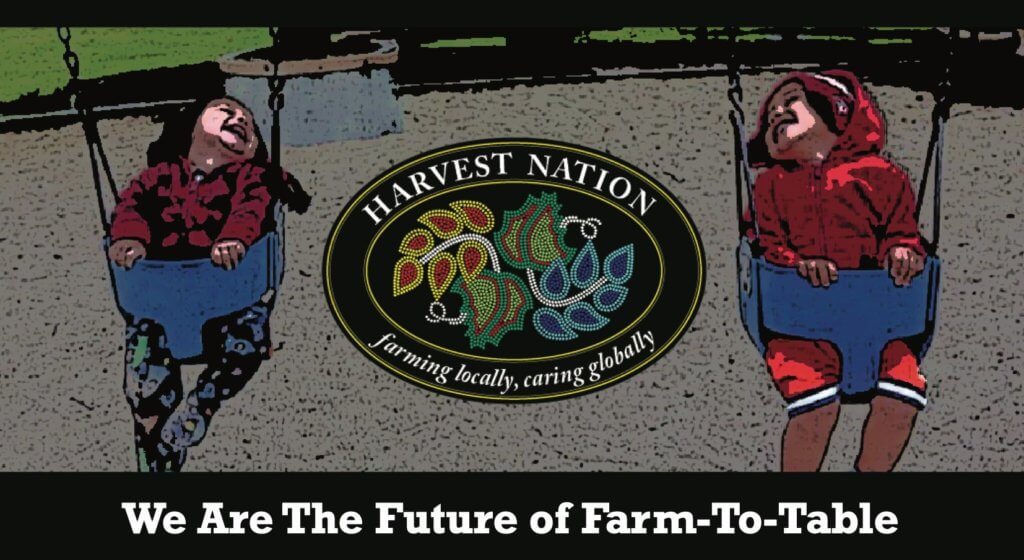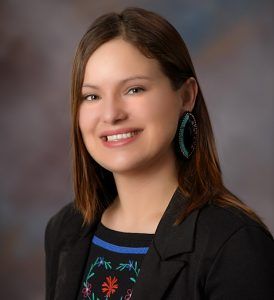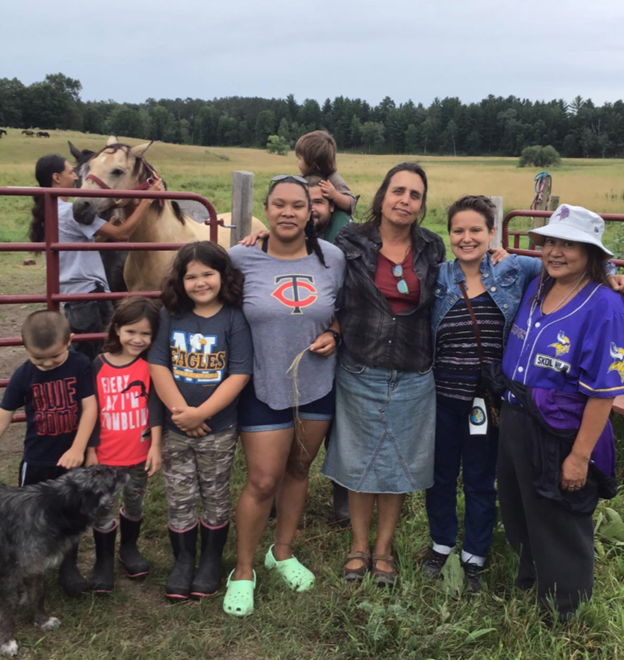 Image: Blog hero Plant Plate 09 boys dig in
Image: Blog hero Plant Plate 09 boys dig in
Harvest Nation brings locally-grown, affordable food options to rural northeast Minnesota

by Alie McInerney Posted in Grants, Rural Capacity Building
Dani Pieratos is one of four Anishinaabeg Ikweg (Indigenous Women) leading a Food Sovernity movement in rural northeast Minnesota under the banner of Harvest Nation. Harvest Nation is a vertical aeroponic farm that makes healthy living a viable option in communities challenged by location, climate, and economic constraint. With access to locally grown foods, Harvest Nation is positively impacting the local economy, quality of food, community health, and the local environment.
In 2019, Harvest Nation received a Blandin Foundation grant for a market feasibility study. Dani is also an alum of the Blandin Foundation Reservation Community Leadership Program.
Written by Dani Pieratos, Harvest Nation president/sales and marketing director

Leading courageously to me means leading by heart. The word courage comes from the Latin word cor for heart. I learned from Roxanne DeLille that Anishinaabeg are people of the heart way.
And leading with the heart means to be humble and allowing myself to be vulnerable. I have layers of trauma and insecurity often steer me in the wrong direction with impulsive reactivity to shrink away from another attempt. Failure after failure is great character building. It’s knowing that I do not know everything and to remain teachable in the ways that help the heart expand and heal. It’s shaking off shame experiences where I either shame myself or when it is offered to me on the path, either intentionally or unconsciously. It’s that humility to admit that I have a long way to go in my personal development, that I’ll never be perfect and will make mistakes in this work. That is just the process. Having the courage to be myself and show up as myself and not try to be something that I am not. I am not polished. But I care. I am wild and crazy and love my people. Accepting this is the greatest gift. As the years go on and I age, maturity comes with sage wisdom from Elders that are free enough to admit “Yes, my girl, I’ve been there too” with loving smiles of hope on their many faces.
Leading courageously means admitting my limitations. I suffer from PTSD so my ability to focus and coordinate is compromised from time to time. It is frustrating and so it is letting go of the guilt of this that has been the hardest part. I try to let people know of this limitation and to remind me of this and that when a deliverable here and there that I’ve promised has yet to be received.
Leading courageously means telling the truth about my personal first-hand accounts of what is going on around me. People are dying in traumatic ways. Family are losing their limbs to diabetes. It’s sickening and I can’t seem to let go of the weight of this.
What makes the world go round (beyond Giichi Manitou, God, the Creator, Allah, Universal Life Force, Jehovah, Yaweh, the Spirit Helpers, that Divine Love, Quantum Physics)? It is Humans. Individual Humans. Human bodies and brains are the mechanism for starts and stops of political spheres for social and economic development. Investing in healthy bodies and minds is the best asset management strategy for any community. Whatever the terror of the day, I believe the human collective can overcome any struggle, and a host of healthy persons is needed for the “all hands on deck” calls to action.
Locally grown food improves regular Average Joe access to healthy food since the mineral, vitamin, nutritional potency of food are optimal when fresh. So many people are sick and human potential limited by overly processed foods. And, of course, pandemics like Covid19 compromise the human capital pool that is left. The sickness itself can take people out with comorbidities while it also jeopardizes food availability in the mass-transport food chain system we have today.
Four Dimensions of the Food Sovereignty Movement
I like the word “movement” used in discussions about Food Sovereignty because the word movement implies action and fluidity. It reflects that there are many moving and dynamic pieces that connect Food Sovereignty ideals altogether.
So let’s get down to the nitty gritty. Below are the four dimensions of Food Sovereignty. I am very new to this movement, and new blogging for that matter. I am by no means an expert.
#1) AFFORDABLE ACCESS TO CULTURALLY APPROPRIATE & HEALTHY FOOD
The Food Sovereignty Movement’s main goal is guaranteeing that people can afford and acquire food that is meaningful to them. What this means for me being a woman in a modernized, globalized world, is that I want it all. To put it in a better way, more dignified way, I like to have options. And I want to have healthy options for me and my family. I also desperately need and want to have food around that also feeds my spirit and my soul, like wild rice and berries. Along those lines, I also need the ability to engage in the social activities surrounding my traditional foods to maintain my identity as an Anishinaabe Ikwe (Indigenous Woman) and connection to my people, my heritage. That’s where I draw strength.
#2) LOCAL FOOD PRODUCTION AND CONTROL OF THE FOOD SYSTEM
Growing and consuming foods locally helps the earth by reducing the use of fossil fuels for long-range transport. It supports the local economy by keeping food dollars in your region, where money is required to develop and sustain a vibrant community. Family farms in Minnesota are now using tracts of their land for renewable energy production. In applying your food budget to buy your food from your local farmer, or growing your own food yourself, you’re securing the future of your community.
When food is locally grown, it makes it easier for the control of the food system to be in the hands of the people (not government, not corporations), where it should be. We are the ones ingesting the food and having to live with the consequences, either good or bad, of however the food system is designed. The food system should be directly accountable and responsive to the desires and needs of the people it serves. If the food system is not meeting the goals what it’s “designed” to do, as in, provide for the nutritional and social needs of a community, the membership should have space to provide input and feedback into that system to make improvements that meet their needs.
#3) EDUCATION
This component is so key to the whole movement and here is my experience to demonstrate the importance of education in the movement.
I grew up in The Matrix, so to speak, where I took a lot of the way we work and live in the U.S. at face-value. I don’t think I really even had a clear, conscious thought about where food actually came from. Of course, if you asked, I would say food comes from farms, but I didn’t think to question the mechanisms for production or delivery. I was so young and dumb to even care much about the health aspect. This changed when I became a mother. I grew up on the heftier side, and packed on the pounds living a not-so-healthy lifestyle. As a mom, I didn’t want my kids to suffer the same fate as I did. We are making changes to eat better now, reversing the curse of being passive consumers of at face-value foods like mac & cheese, hot dogs, white breads and pastas, chips and soda. My apathy was changed in knowing the truth, that I do have a choice, and that it is possible to make these changes to help my family have a better life. That’s what it’s about for us now. Trying and doing better to have a better quality of life. I did not know that I had such power to make change happen.
Educational outreach on behalf of the Food Sovereignty Movement is giving this information to the public so that they are given an option out of The Matrix. The education component is any activity that gives the people what they need to make informed decisions about what food they put into their bodies and why it’s important in the greater context of their communities. It could be anything from cooking instruction to hunting and fishing treaty rights education, to how to combat a sugar addiction.
#4) ENVIRONMENTALLY SOUND PRACTICES
The Food Sovereignty Movement would not be whole without promoting respect and honor in the care of Mother Earth. What use is all of the education, all of the food system changes in support of community wellbeing, and all the healthy food production and consumption, if the land and the water around us is polluted and unable to maintain life into the future? We need sustainable farming practices that guarantee longevity of the natural world so that we have a home for future generations. We only have one planet Earth. We have to keep a special consciousness of this. Examples of environmentally sound practices include using organic pesticides (if they are being used at all), and supporting locally produced foods to cut down on fossil fuel use in excessive transportation.
For more about Harvest Nation, visit their website.
